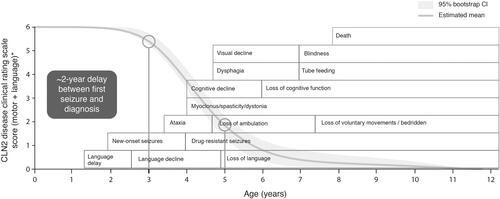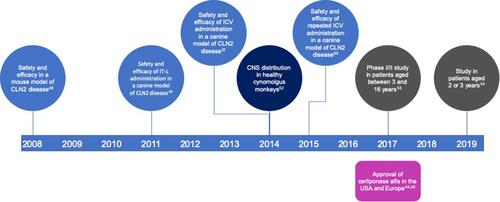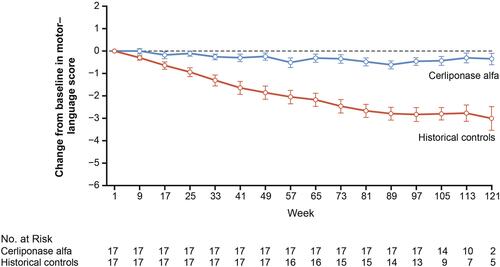Figures & data
Figure 1 The presenting symptoms and progression of CLN2 disease. Reprinted from Lancet Child Adolesc Health; 2(8); Nickel M, Simonati A, Jacoby D, Lezius S, Kilian D, van de Graaf B, Pagovich OE, Kosofsky B, Yohay K, Downs M, Slasor P, Ajayi T, Crystal RG, Kohlschütter A, Sondhi D, Schulz A; Disease characteristics and progression in patients with late-infantile neuronal ceroid lipofuscinosis type 2 (CLN2) disease: An observational cohort study; 582–590; Copyright © 2018 Elsevier Ltd. All rights reserved, with permission from Elsevier.Citation20 Age ranges represent those typical of the classic late-infantile phenotype. The first circle indicates the age at which the period of rapid progression typically begins (3 years), and the second circle indicates the typical age at diagnosis (approximately 5 years). Atypical phenotypes of CLN2 disease can vary in age of onset, rate of progression, and disease manifestation.
Abbreviation: CI, confidence interval.

Table 1 Motor and Language Scores in the CLN2 Disease Clinical Rating Scale
Figure 2 Timeline showing the preclinical and clinical development of cerliponase alfa and the year of its approval in the USA and Europe.
Abbreviations: CNS, central nervous system; ICV, intracerebroventricular; IT-L, intrathecal–lumbar.

Figure 3 Change from baseline in motor and language scores of the CLN2 Disease Clinical Rating Scale in matched pairs of patients treated with cerliponase alfa and historical controls. From N Engl J Med; Schulz A, Ajayi T, Specchio N, de Los Reyes E, Gissen P, Ballon D, Dyke JP, Cahan H, Slasor P, Jacoby D, Kohlschütter A; CLN2 Study Group; Study of intraventricular cerliponase alfa for CLN2 disease; 378(20); 1898–1907. Copyright © 2018 Massachusetts Medical Society. Reprinted with permission from Massachusetts Medical Society.Citation53

